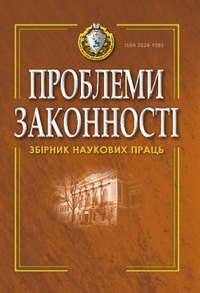Quasidelicts in Ancient Roman Law
DOI:
https://doi.org/10.21564/2414-990x.136.93497Keywords:
obligation, types of obligations, delict (tort), quasidelict, Roman lawAbstract
In ancient Roman law four sources of obligations were recognized, namely: contract, quasicontract, delict and quasidelict. The article addresses quasidelict as a source which gives rise to the obligation. Especially the author tries to find out the historical reasons for erecting the special class of quasidelicts. In this context the author focuses on the discussion over the following question: what distinguishes the quasidelicts from ordinary delicts (torts)? In other words, why did Romans hesitate to qualify some particular cases as delicts (torts) and instead called them «quasidelicts»?
The author analyses in detail the liability of the defendant in each of the cases, which Romans qualified as quasidelicts. In particular, the following cases are contemplated: judge’s offence; when something was thrown or poured onto a public place; when something was suspended or placed in a way as to pose a danger to passers-by; and case of liability for damage inflicted to passengers of a ship, guests of hotel or inn.
The conclusion is reached that quasidelict is a concept to denominate something which resembles delict (tort) but strictly speaking does not constitute a delict due to lack of one or more delict’s essential features. Usually the lacking feature is blameworthiness (or fault) of the defendant.
References
Karnaukh, B.P. (2012). Vyna v ryms’komu pryvatnomu pravi [Fault in Roman Private Law]. Teoriya i praktyka pravoznavstva – Theory and Practice of Jurisprudence, 1(2). Retrieved from: http://tlaw.nlu.edu.ua/article/view/62352/57907 [in Ukrainian].
Dozhdev, D.V. (1996). Rimskoe chastnoe pravo. Moscow: Infra-M [in Russian].
Novitskiy, I.B. & Pereterskiy, I.S. (Eds.) (2012). Rimskoe chastnoe pravo. Moscow: Zertsalo-M [in Russian].
Savigny, F.K. (2004). Obyazatelstvennoe pravo. Saint-Petersburg: Yuridicheskiy tsentr Press [in Russian].
Descheemaeker, E. (2009). The Division of Wrongs: A Historical Comparative Study. New York: Oxford University Press.
Descheemaeker, E. (2009). The Roman Division of Wrongs: A New Hypothesis. Roman Legal Tradition, 5, 1–23.
Vizioz, H. (1912). La notion de quasi-contrat. Etude historique et critique. Bordeaux: Impr. Y. Cadoret [in French].
Chilarzh, K.F. (1906). Uchebnik institutsiy rimskogo prava. Moscow: Pechatnya A. I. Snegirevoy [in Russian].
Baron, Yu. (2005). Sistema rimskogo grazhdanskogo prava. Saint-Petersburg: Yuridicheskiy tsentr Press [in Russian].
Efimov, V.V. (1901). Dogma Rimskogo prava. Saint-Petersburg: A. F. Tsinzerling’s Bookstore [in Russian].
Zaykov, A.V. (2012). Rimskoe chastnoe pravo v sistematicheskom izlozhenii. Moscow: Russian Foundation For Promotion of Education and Science [in Russian].
Downloads
Published
How to Cite
Issue
Section
License
Copyright (c) 2017 Богдан Петрович Карнаух

This work is licensed under a Creative Commons Attribution 4.0 International License.










